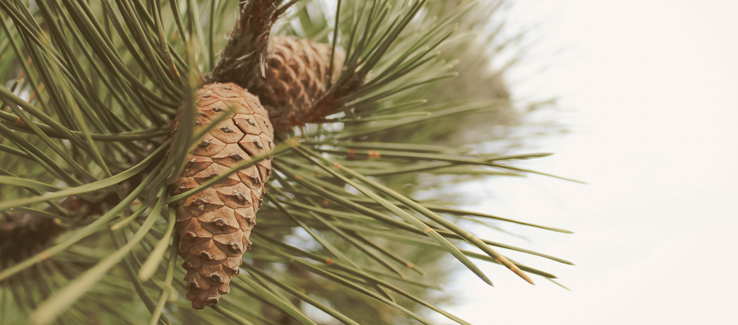
Being one of the most widely spread and most varied class of North American native tree species, it is no mystery as to why pine trees are a popular choice for landscaping.
Due to how easy it is to plant, grow, and care for them, pines are one of (if not the most) valuable of the commercial timber sources. Pines are widely utilized in the making of furniture, in construction, land management, and much more.
Some of the pine species are able to grow 2-3 feet per year while remaining full and vibrant. As well, all pines are evergreen, making their appeal to home owners even greater.
In this article, Fast Tree Removal Services discusses selecting, planting, and caring for pine trees.
Pine Tree Selection and Planting Location
Selecting the right pine tree depends mostly on where it will be planted. Pines are not shade nor drought tolerant, they will need full sun and well irrigated soil to thrive and reach their full potential.
Listed below are a few of the pinus species found in abundance in the City of Atlanta and surrounding areas.
Longleaf Pine – Reaches up to 120 feet tall, with a lifespan of 400 to 500 years.
Eastern White Pine – Reaches up to 150 feet tall, with a lifespan of around 450 years.
Loblolly Pine – Reaches up to 100 feet tall, with a lifespan of 150 years.
The trunk of each of the above species can reach a diameter of 2.5 to 4 feet at maturity, and has an extensive, deep growing root system. Pine trees should not be planted within 15 to 20 feet of fences or other permanent structures, because they have the potential to cause structural damage as they grow.
Pine Tree Care and Common Diseases
Given the right conditions, there isn’t much you will need to do in the way of care for pine trees. As mentioned earlier, they are typically not shade nor drought tolerant, simply making sure that they are well irrigated and get full sun is enough for them to thrive.
Soil – The ideal soil for pine trees is “moist” not dry or wet. This can be accomplished through proper mulching. 2 to 3 inches thick beginning 6 inches from the trunk and spreading out to the edge of the canopy (at least 2 feet to keep mowers far from the trunk and roots).
Fertilizer – In the fall, pines shed old needles. Leave them there! This tree is self-propagating, and its decomposing needles naturally improve the surrounding soil. In effect, it’s FREE mulch that becomes its own fertilizing agent.
Performing a soil test annually will help you to properly fertilize your pine trees. This is an opportunity to correct the pH of the soil and further enrich it if necessary.
Water – During drought conditions, give your trees a deep watering twice a week. At these times, having proper mulching will help the soil retain moisture, thus relieving drought stress.
Under normal conditions, keep the surrounding soil moist for optimum growth and health conditions.
Why Is My Pine Tree Dying From The Bottom Up? – This is a common question which is usually the result of a pine tree drying out. As pines are not drought tolerant, the tree will let the lower branches dry out while sending moisture to the upper branches.
In a way, the tree is stalling for time, waiting for the soil to regain its moisture. You may have to adjust the watering schedule. We advise having the tree professionally evaluated to eliminate the possibility of blight or other possible stressors.
Pests And Disease – While caring for your pines is relatively simple, there are some common pests and diseases to watch for. Some of the pests that feed on and thrive in pine trees are:
- Scale
- Bagworms
- Aphids
- Mites
- Bark Beetles
And some of the diseases that affect the tree’s appearance and health are:
- Needlecast
- Pine Wilt
- Sphaeropsis Tip Blight
- Dothistroma Needle Blight
- Root Rot
In either case, when an infestation or disease is suspected or confirmed, fungicides and pesticides can be used to stop their progression. Calling in a professional tree service to manage these issues is best. In some cases, the only way to protect the rest of your ecosystem is to have the tree removed before the issue spreads.
How Do You Prune a Pine Tree?
Well, you don’t. Shaping, thinning, and aggressive pruning can cause irreparable damage to pine trees.
Occasionally, there will be a situation of abnormal growth, disease, or storm damage which will require pruning. There may eventually be a necessity for crown thinning or crown cleaning. In any of these cases, an arborist or tree professional should be called in to assess the situation and properly execute the required treatment.
Improper pruning, cutting, thinning, or shaping of pine trees (besides causing serious damage) will leave them vulnerable to fungi and infestation.
Pine Trees and Your Landscape

With the right conditions (moist fertile soil and sunlight), adding pine trees to your landscape will provide a significant boost to your ecosystem. Pines grow very fast, they are aromatic, and attract a range of wildlife.
Of the members of your yard’s ecosystem, your pines will likely require the least amount of attention and care. When planting them, be aware that they should not be within 15 to 20 feet of any structure, walkway, driveway, or they will damage, crack, or buckle the concrete.
It is also worth mentioning that once you have a healthy pine tree growing in your yard, you also have a permanent festive outdoor Christmas tree to decorate for the holiday season (at least for a few years).
https://plus.google.com/+Fasttreeremovalatlantaservices(404) 220-9965
To view the orignal version of this post, visit: www.fasttreeremovalatlanta.com/everything-need-know-pine-trees

No comments:
Post a Comment